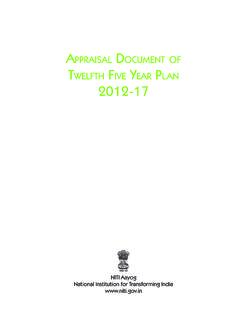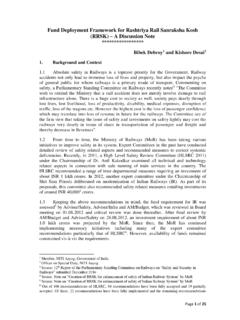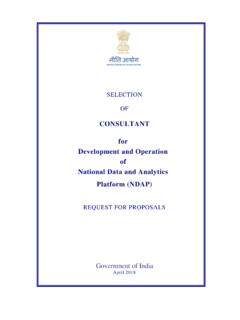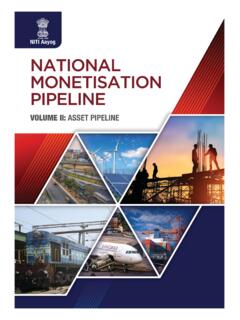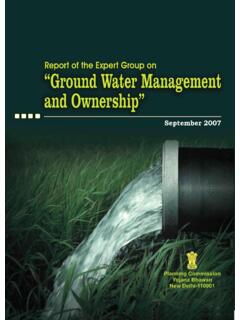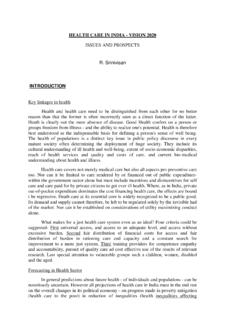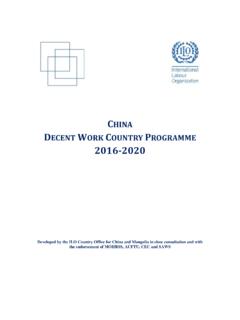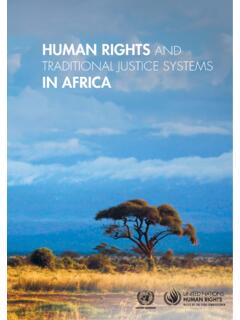Transcription of Inclusive Growth - NITI Aayog
1 Inclusive Growth 1. 1. Inclusive Growth Vision and Strategy INTRODUCTION Scheduled Castes (SCs), Scheduled Tribes (STs), and India has entered the Eleventh Plan period with an minorities. Gender inequality also remains a pervasive impressive record of economic Growth . After a lacklustre problem and some of the structural changes taking place performance in the Ninth Plan period (1997 98 to 2001 have an adverse effect on women. The lack of inclusiveness 02), when gross domestic product (GDP) grew at only is borne out by data on several dimensions of performance. per annum, the economy accelerated in the Tenth Plan period (2002 03 to 2006 07) to record an average The percentage of the population below the official Growth of , the highest in any Plan period so far.
2 Poverty line has come down from 36% in 1993 94 to Besides, there was acceleration even within the Tenth Plan 28% in 2004 05. However, not only is this still high, the period and the Growth rate in the last four years of the rate of decline in poverty has not accelerated along with Plan has averaged , making India one of the fastest the Growth in GDP, and the incidence of poverty among growing economies in the world. certain marginalized groups, for example the STs, has hardly declined at all. Because population has also grown, It can be argued that there is an element of cyclicality the absolute number of poor people has declined only in the high Growth observed in the past four years since marginally from 320 million in 1993 94 to 302 million in these were also years of a global upswing.
3 However, India's 2004 05. This performance is all the more disappointing Growth performance goes beyond mere cyclicality. It is since the poverty line on which the estimate of the poor underpinned by a number of factors which are real sources is based is the same as it was in 1973 74 when per capita of strength and will serve us well in the years ahead. Savings incomes were much lower. Other indicators of deprivation and investment rates have increased significantly. The suggest that the proportion of the population deprived industrial sector has responded well to economic reforms of a minimum level of living is much higher.
4 For example, and has shown that it is capable of competing in the National Family Health Survey-3 (NFHS-3) shows that global economy. Perceptions about India among global almost 46% of the children in the 0 to 3 years' age group investors are very favourable. These developments suggest suffered from malnutrition in 2005 06, and what is even that the economy is now at a point when it can achieve more disturbing is that the estimate shows almost no sustained economic expansion that has the potential to decline from the level of 47% reported in 1998 by NFHS-2. bring significant improvement in the lives of our people. If this momentum can be accelerated in the years ahead, Indicators of human development such as literacy it will put India on the path to becoming one of the key and education, and maternal and infant mortality rates, players in the world economy over the next two decades.
5 Show steady improvement, but they also suggest that the progress is slow and we continue to lag behind several other These positive factors notwithstanding, a major Asian countries. While the literacy rate has gone up from weakness in the economy is that the Growth is not perceived in 1951 to in 2001, the number of illiterate as being sufficiently Inclusive for many groups, especially persons still exceeds 304 million, making India the 2 Eleventh Five Year Plan country with the highest number of illiterate persons in ensures broad-based improvement in the quality of life the world. Life expectancy at birth has increased from of the people, especially the poor, SCs/STs, other backward approximately 32 years for both males and females in castes (OBCs), minorities and women.
6 The National 1951 to years for males and years for females in Development Council (NDC), in approving the Approach 2001 06. Yet this is well below the life expectancy of to the Eleventh Plan, endorsed a target of 9% GDP Growth around 80 years in industrialized countries and 72 years for the country as a whole. This Growth is to be achieved in China. Although Indian women now have higher life in an environment in which the economy is much more expectancy than Indian men, as is the case in industrialized integrated into the global economy, an integration that countries, India also has an adverse sex ratio with only has yielded many benefits but also poses many challenges.
7 933 women per 1000 men. More disturbing, the child sex If this is achieved, it would mean that per capita GDP. ratio (ages 0 6) has declined sharply from 962 in 1981 to would grow at about per year to double in less than 927 in 2001. India's maternal and infant mortality rates are ten years. However the target is not just faster Growth much higher than those of countries in East Asia, showing but also Inclusive Growth , that is, a Growth process which poor access to essential health care services. yields broad-based benefits and ensures equality of opportunity for all. The composition of Growth in recent years has also presented some problems.
8 Agriculture has grown very This broad vision of the Eleventh Plan includes several slowly from the Ninth Plan onwards and this has widened inter-related components: rapid Growth that reduces the rural urban divide and also contributed to the severe poverty and creates employment opportunities, access distress in rural areas in some regions. Although there is to essential services in health and education especially an upturn in agricultural Growth after 2004, it is too early for the poor, equality of opportunity, empowerment to be complacent. Total employment in the economy has through education and skill development, employment improved in recent years, but the labour force has grown opportunities underpinned by the National Rural Employ- even faster, leading to an increase in the unemployment ment Guarantee, environmental sustainability, recognition rate.
9 Permanent employment in the organized sector has of women's agency and good governance. decreased, although organized sector firms may be increasing their informal employment. Also, economic RAPID Growth AND POVERTY REDUCTION. Growth across regions has not been balanced, with The persistence of poverty on the scale at which it some of the most backward areas yet to experience any still exists is not acceptable. A decisive reduction in poverty significant Growth . The delivery of essential social services and an expansion in economic opportunities for all at the grass roots level is also poor and this is a major sections of the population should therefore be a crucial causative factor in unequal development.
10 Much higher element of the vision for the Eleventh Plan. Rapid Growth levels of human development can be achieved even with of the economy is an essential requirement to achieve this the given structure of the economy, if only the delivery outcome since it is an instrument for achieving a steady system is improved. increase in employment and incomes for large numbers of our people. These features suggest that while there are significant economic achievements that India can celebrate in its Growth in the Eleventh Plan should be better 60th year of Independence, it is still far from redeeming balanced to rapidly create jobs in the industrial and the pledge which Pandit Jawaharlal Nehru made on the services sectors.
